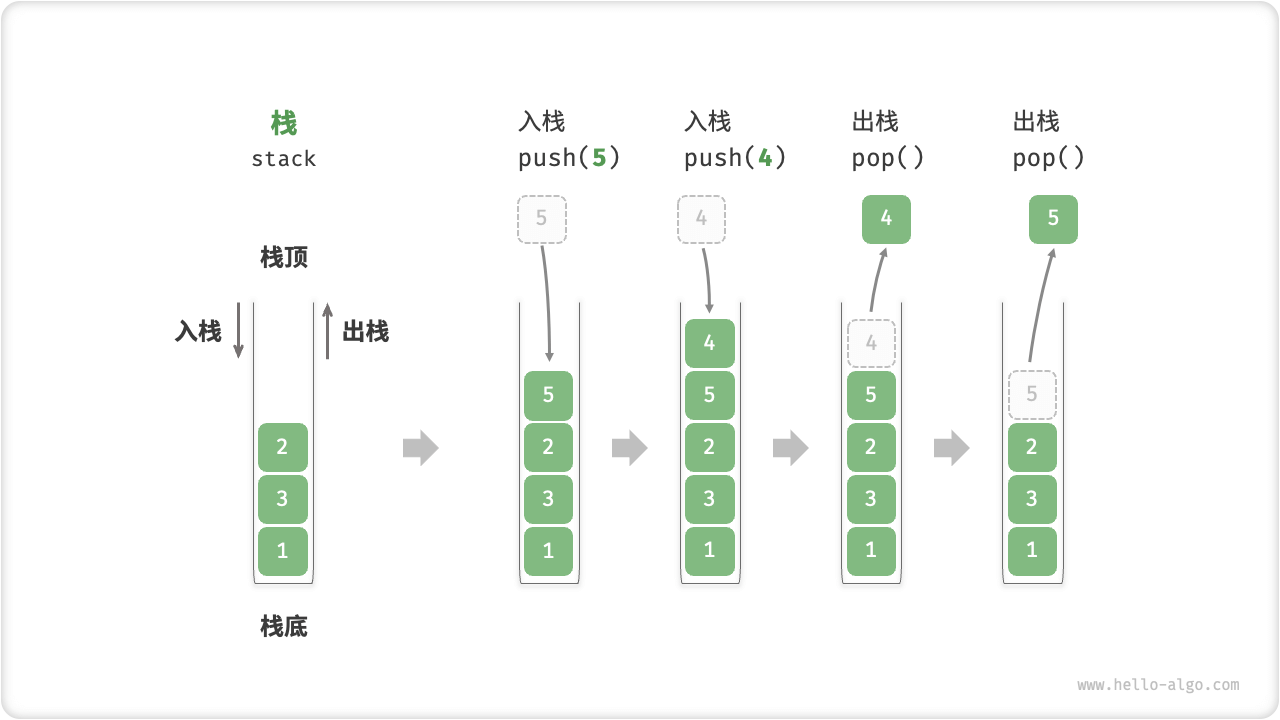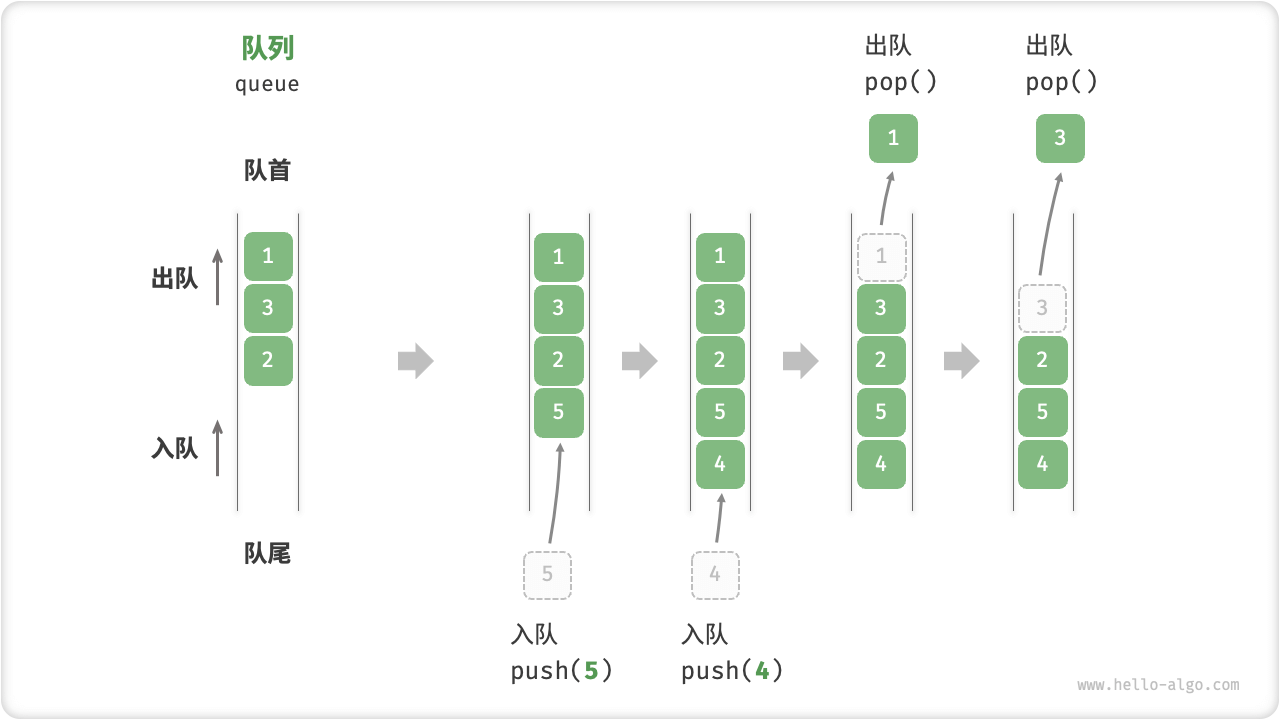ArrayDeque 源码解析
# 1、Stack 和 Queue 和 Deque
在讲解ArrayDeque之前,我们先对Stack(栈)、Queue(队列)和Deque(双向队列)进行解析一下。
# 1.1、Stack
栈(Stack)是一种遵循先入后出的逻辑的线性数据结构。
栈的先入后出规则

Java中有个Stack类,它是Vector的子类。但是Java已不推荐使用Stack,而是推荐使用更高效的ArrayDeque。
# 1.2、Queue
队列(Queue)是一种遵循先入先出规则的线性数据结构。
队列的先入先出规则

Java中的Queue接口继承了Collection接口。除了Collection的方法外,Queue还提供了一些额外方法,分别对应插入、删除和检查操作。
| 方法 | 说明 |
|---|---|
| add(E e) | 添加元素到队列的末尾,如果队列已满,则抛出IllegalStateException异常。 |
| offer(E e) | 添加元素到队列的末尾,如果队列已满,则返回false。 |
| remove() | 移除并返回队列头部的元素,如果队列为空,则抛出NoSuchElementException异常。 |
| poll() | 移除并返回队列头部的元素,如果队列为空,则返回null。 |
| element() | 返回队列头部的元素,但不移除它,如果队列为空,则抛出NoSuchElementException异常。 |
| peek() | 返回队列头部的元素,但不移除它,如果队列为空,则返回null。 |
# 1.3、Deque
双向队列(Deque:double-ended queue) 提供了更高的灵活性,允许在头部和尾部执行元素的添加或删除操作。
双向队列入队出对

Java中的Deque接口继承了Queue接口。除了Queue的方法外,Deque还提供了一些额外方法。
| 方法 | 说明 |
|---|---|
| addFirst(E e) | 在双端队列的头部添加元素,如果队列已满,则抛出IllegalStateException异常。 |
| addLast(E e) | 在双端队列的尾部添加元素,如果队列已满,则抛出IllegalStateException异常。 |
| offerFirst(E e) | 在双端队列的头部添加元素,如果队列已满,则返回false。 |
| offerLast(E e) | 在双端队列的尾部添加元素,如果队列已满,则返回false。 |
| removeFirst() | 移除并返回双端队列的头部元素,如果队列为空,则抛出NoSuchElementException异常。 |
| removeLast() | 移除并返回双端队列的尾部元素,如果队列为空,则抛出NoSuchElementException异常。 |
| pollFirst() | 移除并返回双端队列的头部元素,如果队列为空,则返回null。 |
| pollLast() | 移除并返回双端队列的尾部元素,如果队列为空,则返回null。 |
| getFirst() | 返回双端队列的头部元素,但不移除它,如果队列为空,则抛出NoSuchElementException异常。 |
| getLast() | 返回双端队列的尾部元素,但不移除它,如果队列为空,则抛出NoSuchElementException异常。 |
| peekFirst() | 返回双端队列的头部元素,但不移除它,如果队列为空,则返回null。 |
| peekLast() | 返回双端队列的尾部元素,但不移除它,如果队列为空,则返回null。 |
Deque的接口虽然有很多,但无非都是对两端的增删改查。Deque作为双向队列的首选实现类是ArrayDeque,其次选择LinkedList。
# 2、ArrayDeque 源码解析
ArrayDeque特性
- ArrayDeque的底层实现是数组,相比于LinkedList,ArrayDeque通常会提供更快的插入和移除元素的性能。
- ArrayDeque会进行动态扩容,当队列容量满时,扩容大小为原大小的2倍。因此,当预期数量大时,使用初始容量创建ArrayDeque会更有效率,避免频繁扩容带来的性能损耗。
- ArrayDeque在内部实现上使用了循环数组(Circular Array)的机制。
- ArrayDeque是非线程安全的(not thread-safe)
- ArrayDeque不支持null元素。
循环数组
循环数组是一个数组和一个指针,指针的移动是在这个数组的开始和结束之间进行的,如同指针在数组的末尾和数组的开始之间形成了一个循环。

- 在ArrayDeque中,有两个指针:head和tail。head指针总是指向队列的头部元素,tail指针总是指向队列的下一个空位。
- 当我们向ArrayDeque添加元素时,如果tail已经移动到数组的末尾并且数组没有满,那么tail会回到数组的开头;当我们从ArrayDeque中移除元素时,如果head已经移动到数组的末尾,那么head会回到数组的开头。这就是ArrayDeque的数据结构的精妙之处,它的实现相当于一个环形队列。
- 如果插入元素时发现数组已满,那么ArrayDeque会将内部数组的容量扩大一倍,然后将原有元素迁移到新的数组中。但在转移过程中,新数组中元素的布局依然保持原来的循环数组规则,这也是为什么称之为动态扩容的循环数组。
- 通过这种方式,ArrayDeque可以提供在队列两端插入和删除的复杂度为O(1),同时避免了频繁的内存分配和数组复制。
源码
public class ArrayDeque<E> extends AbstractCollection<E>
implements Deque<E>, Cloneable, Serializable
{
/**
* The array in which the elements of the deque are stored.
* The capacity of the deque is the length of this array, which is
* always a power of two. The array is never allowed to become
* full, except transiently within an addX method where it is
* resized (see doubleCapacity) immediately upon becoming full,
* thus avoiding head and tail wrapping around to equal each
* other. We also guarantee that all array cells not holding
* deque elements are always null.
*/
transient Object[] elements; // non-private to simplify nested class access
/**
* The index of the element at the head of the deque (which is the
* element that would be removed by remove() or pop()); or an
* arbitrary number equal to tail if the deque is empty.
*/
transient int head;
/**
* The index at which the next element would be added to the tail
* of the deque (via addLast(E), add(E), or push(E)).
*/
transient int tail;
/**
* The minimum capacity that we'll use for a newly created deque.
* Must be a power of 2.
*/
private static final int MIN_INITIAL_CAPACITY = 8;
// ...
}
2
3
4
5
6
7
8
9
10
11
12
13
14
15
16
17
18
19
20
21
22
23
24
25
26
27
28
29
30
31
32
33
34
35
36
- elements:用于存储队列中的元素。
- head:表示在队列中头部元素的索引,也就是会被remove()或pop()方法删除的元素的索引;如果队列为空,则head与tail的值相同。
- tail:表示下一个元素会被添加到队列尾部的位置的索引,通过addLast(E),add(E),或push(E)方法添加的元素都会被添加的这个位置。
- MIN_INITIAL_CAPACITY:表示新创建的队列的最小初始容量,也确保了队列容量始终为2的幂。
# 2.1、构造函数
ArrayDeque提供了多个构造函数。用法和ArrayList差不多,这里不再赘述。
源码
public ArrayDeque() {
elements = new Object[16];
}
/**
* Constructs an empty array deque with an initial capacity
* sufficient to hold the specified number of elements.
*
* @param numElements lower bound on initial capacity of the deque
*/
public ArrayDeque(int numElements) {
allocateElements(numElements);
}
/**
* Constructs a deque containing the elements of the specified
* collection, in the order they are returned by the collection's
* iterator. (The first element returned by the collection's
* iterator becomes the first element, or <i>front</i> of the
* deque.)
*
* @param c the collection whose elements are to be placed into the deque
* @throws NullPointerException if the specified collection is null
*/
public ArrayDeque(Collection<? extends E> c) {
allocateElements(c.size());
addAll(c);
}
private void allocateElements(int numElements) {
int initialCapacity = MIN_INITIAL_CAPACITY;
//做移位与运算最后加一得到比给定长度大的最小的2的幂数。
if (numElements >= initialCapacity) {
initialCapacity = numElements;
initialCapacity |= (initialCapacity >>> 1);
initialCapacity |= (initialCapacity >>> 2);
initialCapacity |= (initialCapacity >>> 4);
initialCapacity |= (initialCapacity >>> 8);
initialCapacity |= (initialCapacity >>> 16);
initialCapacity++;
if (initialCapacity < 0) // Too many elements, must back off
initialCapacity >>>= 1;// Good luck allocating 2 ^ 30 elements
}
elements = new Object[initialCapacity];
}
2
3
4
5
6
7
8
9
10
11
12
13
14
15
16
17
18
19
20
21
22
23
24
25
26
27
28
29
30
31
32
33
34
35
36
37
38
39
40
41
42
43
44
45
46
allocateElements解析
对于一个给定长度,先判断是否小于定义的最小长度,如果小于,则使用定义的最小长度作为数组的长度。否则,找到比给定长度大的最小的2的幂数

# 2.2、addFirst()
addFirst()在队列的首端插入元素,数组没有越界就比较简单了,直接elements[--head] = e就可以了。
首端插入过程中会遇到两个问题:
- 首端(head)的索引下标为0,需要将插入的位置改为数组的最后一个位置。
- 空间不够,需要扩容。
接下来先看源码再解析
源码
/**
* Inserts the specified element at the front of this deque.
*
* @param e the element to add
* @throws NullPointerException if the specified element is null
*/
public void addFirst(E e) {
if (e == null)
throw new NullPointerException();
elements[head = (head - 1) & (elements.length - 1)] = e;
if (head == tail)
doubleCapacity();
}
/**
* Doubles the capacity of this deque. Call only when full, i.e.,
* when head and tail have wrapped around to become equal.
*/
private void doubleCapacity() {
assert head == tail;
int p = head;
int n = elements.length;
int r = n - p; // number of elements to the right of p
int newCapacity = n << 1;
if (newCapacity < 0)
throw new IllegalStateException("Sorry, deque too big");
Object[] a = new Object[newCapacity];
System.arraycopy(elements, p, a, 0, r);
System.arraycopy(elements, 0, a, r, p);
elements = a;
head = 0;
tail = n;
}
2
3
4
5
6
7
8
9
10
11
12
13
14
15
16
17
18
19
20
21
22
23
24
25
26
27
28
29
30
31
32
33
34
将元素插入到head前一位,同时修改head值。判断内存是否足够,若不够,扩容为原数组的两倍。然后通过System.arraycopy(),将原来数组的元素复制到新数组中。
解析过程:
head插入时,判断是否为null,Deque不允许有null的元素。elements[head = (head - 1) & (elements.length - 1)] = e;,这段代码就解决了下标越界问题。
- 当head ≠ 0时
因为element数组的内存大小为2的n次幂,因此(elements.length-1)的二进制为全1,(head - 1) & (elements.length - 1)值始终为head-1的值。即在element[head-1]插入元素。
- 当head = 0时
head - 1 = -1时,其中-1用二进制表示为全1,与elements.length - 1相与,结果为elements.length - 1的值,即在数组的末尾插入元素。
- 扩容
doubleCapacity()将新建一个数组,大小为原来的两倍,并分两次来复制,第一次复制head右边的元素,第二次复制head左边的元素。

# 2.3、addLast()
addLast()是在Deque的尾部(tail)直接插入元素,因为tail的位置总是为空的,所以直接elements[tail] = e插入就行。
源码
public void addLast(E e) {
if (e == null) // 不允许放入null
throw new NullPointerException();
elements[tail] = e; // 赋值
if ((tail = (tail + 1) & (elements.length - 1)) == head)// 下标越界处理
doubleCapacity();// 扩容
}
2
3
4
5
6
7
解析过程
- 判断元素是否为空,不为空直接赋值给tail位置即可
- 判断插入之后,下标是否越界,处理方式跟
addFirst()一样 - 扩容,也跟
addFirst()一样
# 2.4、pollFirst()
pollFirst()的作用是删除并返回Deque首端元素,也即是head位置处的元素。如果容器不空,只需要直接返回elements[head]即可,当然还需要处理下标的问题。由于ArrayDeque中不允许放入null,当elements[head] == null时,意味着容器为空。
源码
public E pollFirst() {
int h = head;
E result = elements[head];
if (result == null)//null值意味着deque为空
return null;
elements[h] = null;//let GC work
head = (head + 1) & (elements.length - 1);//下标越界处理
return result;
}
2
3
4
5
6
7
8
9
# 2.5、pollLast()
pollLast()的作用是删除并返回Deque尾端元素,也即是tail位置前面的那个元素。
源码
public E pollLast() {
int t = (tail - 1) & (elements.length - 1);//tail的上一个位置是最后一个元素
E result = elements[t];
if (result == null)//null值意味着deque为空
return null;
elements[t] = null;//let GC work
tail = t;
return result;
}
2
3
4
5
6
7
8
9
# 2.6、peekFirst()
peekFirst()的作用是返回但不删除Deque首端元素,也即是head位置处的元素,直接返回elements[head]即可。
源码
public E peekFirst() {
return elements[head]; // elements[head] is null if deque empty
}
2
3
# 2.7、peekLast()
peekLast()的作用是返回但不删除Deque尾端元素,也即是tail位置前面的那个元素。
源码
public E peekLast() {
return elements[(tail - 1) & (elements.length - 1)];
}
2
3
# 3、ArrayDeque常用方法
| 方法 | 说明 |
|---|---|
| add(E e) | 向队列尾部添加元素。不推荐使用该方法,因为它与Queue的add方法在功能上有重复,建议 使用offer代替。 |
| addFirst(E e) | 在队列的头部添加元素。 |
| addLast(E e) | 在队列的尾部添加元素。 |
| offer(E e) | 向队列尾部添加元素,如果因为容量限制添加失败会返回false,而不是抛出异常。 |
| offerFirst(E e) | 在队头添加元素,如果因为容量限制添加失败会返回false,而不是抛出异常。 |
| offerLast(E e) | 在队尾添加元素,如果因为容量限制添加失败会返回false,而不是抛出异常。 |
| remove() | 移除并返回队头元素,如果队列为空,则抛出NoSuchElementException异常。 |
| removeFirst() | 移除并返回头部元素,如果队列为空,则抛出NoSuchElementException异常。 |
| removeLast() | 移除并返回尾部元素,如果队列为空,则抛出NoSuchElementException异常。 |
| poll() | 移除并返回队头元素,如果队列为空,则返回null。 |
| pollFirst() | 移除并返回头部元素,如果队列为空,则返回null。 |
| pollLast() | 移除并返回尾部元素,如果队列为空,则返回null。 |
| getFirst() | 获取,但是不移除头部元素。如果队列为空会抛出NoSuchElementException异常。 |
| getLast() | 获取,但是不移除尾部元素。如果队列为空会抛出NoSuchElementException异常。 |
| peek() | 获取,但是不移除头部元素。如果队列为空会返回null。 |
| peekFirst() | 获取,但是不移除头部元素。如果队列为空会返回null。 |
| peekLast() | 获取,但是不移除尾部元素。如果队列为空会返回null。 |
| size() | 返回队列中元素的个数。 |
| clear() | 清空队列中的所有元素。 |
| isEmpty() | 检查队列是否为空。如果为空返回true,否则返回false。 |
| contains(Object o) | 检查队列是否包含指定元素。如果包含返回true,否则返回false。 |
